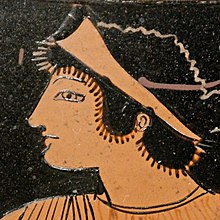Pioneer group

A group of ancient vase painters from Athens of the red-figure style is referred to in modern research as a pioneer group , also known as (the) pioneers .
Having been in the pottery workshop of Andokides , probably by the Andokides painter was invented, the Red-figure style, experimented some vase painters with the new style. These early, experimental painters included the Andokides painter, for example, Psiax , Paseas and the Goluchow painter , who all used the previous black-figure style in addition to the red-figure style .
The pioneer group also experimented, but no longer with the style of painting as such (Boardman: the mechanics), but with its possibilities (Boardman: the essence). John Boardman described the group as "the most interesting of all painters who were ever active in the pottery district of Athens, and not only because of their artistic merits, but also because of their nature and togetherness as a group". As with all vase painters, there is no written record and when assessing the group of pioneers one only has to fall back on archaeological sources, but the pioneers appear as the first association or at least as the first artistic movement in Western art. The reconstruction of their career, their common goals and their rivalries is seen by many as the “triumph of archaeological research”.
The most important representatives of the group were Euphronios , who some archaeologists consider the best Greek vase painter - at least of the red-figure style -, Smikros , Euthymides , Phintias , Hypsis , the Dikaios painter , the Gales painter , the painter of Acropolis 24 , the Pythocles Painters , the Pezzino group and the Sosias painter . What set them apart from their predecessors and successors was the fact that they were "accomplished artists". John D. Beazley describes Smikros as "not a good draftsman", but this is only true within the group. The group's drawings and compositions were of outstanding quality. Above all the representation of the details and anatomical conditions reached a hitherto unknown bloom. The narrative content of the representations exceeds anything that was created by the artists up to this point in time. With preference they painted vases larger types such as craters , amphorae , Psyktere and hydriai , but were also on smaller objects such as bowls and plates masters of their trade.
Her ability to write is also of particular interest. Many of her vases were provided with inscriptions, some of which describe the figures, depict favorite inscriptions or even contain bits of language, as in modern comics . In addition to a particularly successful anatomical study, Euthymides boasted in an inscription "as [it] Euphronios never could". This testified in a very special way to the rivalry within the group. In many places you can tell the painters their pride as artists and craftsmen as well as citizens. Euthymides often expressed his pride with signatures that have probably never been as common before and since as within the group. Sometimes he would add that of his father to his own name. Euthymides himself is greeted on two vases of the group that could not be clearly assigned to any painter (“chaireto Euthymides” and “Euthymides chaire”). A lyre player is described as Euthymides on a Phintias vase and a woman toasts him. Smikros depicts himself as a drinker on a vase and is probably depicted in the same way on a Euphronius vase. Apparently, the artists not only drew symposium scenes , but also belonged to the middle class who could afford such a thing. Or, however, they wanted to belong to it and therefore presented themselves in this way. Smikros is also mentioned in Euphronios' favorite inscription. Other frequently mentioned ephebes on such inscriptions were Leoagros , Philiades, Phayllus , Sosias (Sosis) and Antias.
Various similarities in the group can also be seen in the drawings. What they all have in common is that they show an interest in colors, such as B. White for the skin of women. With the exception of Euphronios, they did not bother to depict complicated robe patterns in the style of black-figure painters. Hair contours are no longer scratched and the best work involved using the relief line . The representation of objects such as shields approaches a real linear perspective foreshortening, which is not yet possible with anatomical details. New painting techniques are developed. Standing figures are shown in three-quarter view, one leg is shown in profile, another in front view. With this technique you were a generation ahead of the sculptors. Nevertheless, none of the artists is able to show a head in profile and the body in frontal view without distorting it unnaturally. The frontal views of female breasts are also consistently shown anatomically incorrect.
Some of the painters like Euphronios and Phintias ran their own pottery workshops at a later stage in their careers. As owners of the workshops, potters were more prestigious and important than the vase painters they employed. Many of the most important painters of the next generation can still be recognized today as students of the pioneer group. These include the Cleophrades painter , the Berlin painter and Onesimos , who worked in Euphronios' pottery workshop. The pioneers also had a great influence on the bowl painters who were active around the time of the pioneer group, such as Oltos , the Nikosthenes painter and Epiktetos .
literature
- John Boardman : Red-Figure Vases from Athens. The archaic time (= cultural history of the ancient world . Vol. 4). 4th edition. Philipp von Zabern, Mainz 1994, ISBN 3-8053-0234-7 .
Web links
credentials
- ^ John Boardman : Red Figure Vases from Athens , p. 32
- ^ John Boardman: Red Figure Vases from Athens , p. 32
- ↑ John Boardman: Red Figure Vases from Athens , p. 33
- ↑ quoted from John Boardman: Rotfigurige Vasen aus Athen , p. 32


